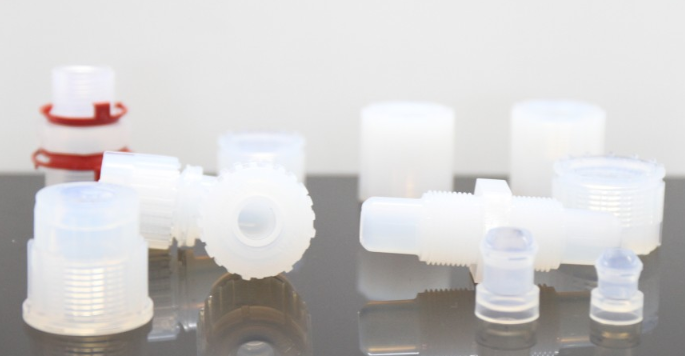
Teflon, known chemically as Polytetrafluoroethylene (PTFE), presents unique challenges when it comes to injection molding. Unlike many other thermoplastics, PTFE has properties that make it difficult to mold using conventional injection molding techniques. Here’s a detailed look at the issues and alternative methods for processing PTFE:
Properties of PTFE
- High Melting Point:
- PTFE has an extremely high melting point of around 327°C (621°F).
- Viscosity:
- Even when melted, PTFE has a very high viscosity, making it difficult to flow into mold cavities.
- Chemical Resistance:
- PTFE is highly resistant to almost all chemicals.
- Low Friction:
- It has one of the lowest coefficients of friction of any solid material.
- Thermal Stability:
- It maintains its properties over a wide temperature range, from -200°C to 260°C (-328°F to 500°F).
- Electrical Insulation:
- PTFE is an excellent electrical insulator.
[elementor-template id=”4330″]
Challenges in Injection Molding PTFE
- High Melting Point and Viscosity:
- The high melting point and viscosity make it nearly impossible to inject PTFE using standard injection molding techniques.
- Decomposition:
- PTFE starts to decompose before it reaches a flowable state, which can release harmful gases.
Alternative Methods for Processing PTFE
Due to these challenges, alternative processing methods are typically used for PTFE:
- Compression Molding:
- PTFE powder is placed into a mold and compressed at high pressure, then sintered (heated) to form the final shape.
- Ram Extrusion:
- PTFE powder is compressed and heated in a chamber, and then forced through a die to create long shapes like rods or tubes.
- Isostatic Molding:
- PTFE powder is placed in a flexible mold within a pressure chamber. The chamber is filled with fluid, and pressure is applied uniformly from all directions.
- Paste Extrusion:
- PTFE is mixed with a lubricant to form a paste, which is then extruded and subsequently heated to remove the lubricant and sinter the PTFE.
- Skiving:
- This is a post-processing method where thin layers are shaved off a block of sintered PTFE to produce films or sheets.
[elementor-template id=”4331″]
Applications of PTFE
Despite the challenges in processing, PTFE is used in various applications due to its unique properties:
- Chemical Processing Equipment:
- Linings for pipes, tanks, and valves.
- Aerospace:
- Insulation for wiring and components exposed to high temperatures.
- Electronics:
- Insulating materials for cables and connectors.
- Medical:
- Components in medical devices and implants due to its biocompatibility.
- Consumer Goods:
- Non-stick coatings for cookware.
Conclusion
While PTFE cannot be easily injection molded using conventional techniques due to its high melting point and viscosity, alternative methods such as compression molding, ram extrusion, and isostatic molding are commonly used to process this versatile material. These methods leverage PTFE’s unique properties, making it indispensable in industries requiring high chemical resistance, low friction, and excellent thermal stability.
Related Conten: Industrial Molds
 DTG Mould Trade Process |
|
| Quote: | According to sample, drawing and specific requirement. |
|---|---|
| Discussion | Mold material, cavity number, price, runner, payment, etc. |
| S/C Signature | Approval for all the items. |
| Advance | Pay 50% by T/T |
| Product Design Checking | We check the product design. If some position is not perfect, or can not be done on the mould, we will send customer the report. |
| Mold Processing | Send report to customer once each week |
| Mold Testing | Send trial samples and try-out report to customer for confirmation |
| Mold Modification | According to customer’s feedback. |
| Balance Settlement | 50% by T/T after the customer approved the trial sample and mould quality. |
| Delivery | Delivery by sea or air. The forwarder can be designated by your side. |
 |
|

